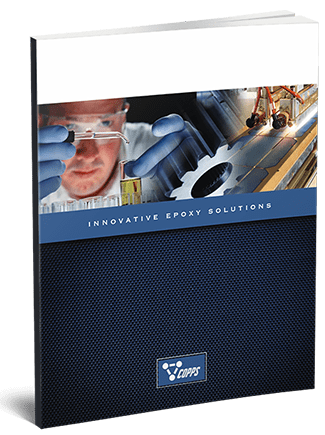What Is Epoxy Grout?
Industrial-grade epoxy grout is a compound consisting of an epoxy resin combined with an engineered aggregate. The resulting material exhibits excellent resistance to damage and degradation resulting from chemical corrosion, heat, moisture, vibration, repeated dynamic loading, and other operational and environmental stresses. These qualities make it highly suitable for application beneath the base plates of process machinery and other heavy equipment used for industrial purposes as its durability and longevity help ensure the units remain securely mounted to the sole plates affixed to the concrete foundation.
There are numerous types of epoxy grout available. Many of them have bond strength, chemical resistance, and alignment performance that surpass cementitious grout in most applications.
How Epoxy Grout Works
The application of industrial-grade epoxy grout underneath the base plates of heavy machinery can provide full contact load transfer to the concrete foundation, which helps isolate vibrations and ensure secure installation. However, the compound must be applied properly to achieve these benefits. The typical epoxy grout application process is as follows:
How Epoxy Grout Works
The application of industrial-grade epoxy grout underneath the base plates of heavy machinery can provide full contact load transfer to the concrete foundation, which helps isolate vibrations and ensure secure installation. However, the compound must be applied properly to achieve these benefits. The typical epoxy grout application process is as follows:
-
Surface Preparation
The surfaces of the base/sole plates are sandblasted to a “white metal” condition. If grout application will not occur within 24 hours of surface preparation, the plates need to be primed with a non-aqueous primer. Additionally, the anchor bolts should be coated with a thick layer of paste wax or grease.
-
Mixing
The epoxy grout needs to be mixed prior to application. This process can vary depending on the type of grout. For example:
- Two-component grout consists of a resin and a hardener. First, the resin is premixed, and then the hardener is poured into it. Finally, the mixture is mixed until it is uniform in color, which typically takes three to four minutes.
- Three-component grout consists of a resin, a hardener, and an aggregate. First, the hardener and resin are mixed until a uniform color is attained. This mixture is then poured into a mortar mixer and combined with aggregate. Finally, the compound is mixed until all of the aggregate is wetted, which typically takes three to four minutes.
-
Application
Once the epoxy grout mixture is prepared, it can be placed immediately. Sweeping the grout from one base side to the other helps eliminate air entrapment, which can interfere with the performance of the grout.
Advantages of Using Epoxy Grout
Epoxy grout offers a number of advantages over traditional cementitious grout, such as:
Higher Strength
While cement grout is generally less expensive than epoxy grout, it is best suited for smooth running equipment that exhibits minimal or static load impact. In contrast, epoxy grout can be specifically developed for a range of demanding environments, including those with excessive temperatures, vibrations, weather factors, and chemical interactions.
Faster Strength Development
Industrial epoxy grouts cure and develop compressive strength much quicker than cement grouts. They cure within hours and feature the same characteristics as month-old, fully cured cement grout. As a result, grouting-to-equipment startup can be performed within a single day, which practically eliminates machinery downtime.
Easier Anchor Setting Requirements
The excellent compressive and tensile strength, fast cure times, and high bond strength of epoxy grouts are ideal for anchoring. Additionally, epoxy grouts minimize the risk of voids and entrapments that can form near the bolts during the setting of heavy equipment or process machinery. In combination with anchor bolts, they help keep large generators, wind turbines, metalworking mills, and other industrial equipment securely in place.
When to Use Epoxy Grout
Epoxy grouts are a suitable alternative to cementitious grouts for many applications. However, they are the ideal option for ensuring secure installation and stabilization of industrial equipment in demanding environments. Since the compounds offer greater bond strength, alignment performance, and chemical resistance than cementitious grouts, they are better at withstanding extreme conditions.
Applications of Epoxy Grout
Epoxy grout has become a popular substitute for cementitious grouts in a range of applications. Examples of typical uses include:
- Anchoring heavy machinery. Epoxy grout ensures proper load transfer between the base and sole plate, providing a secure and anchored work surface during the equipment’s operational life. Traditional cement grout is used primarily for static loads since it is prone to cracking, which can expose vulnerabilities such as voids, leaks, and un-leveled base plates. Grouting machinery with an epoxy compound dissipates vibrational impact, repels excessive heat, and resists chemical attacks from alkalis, oils, acids, and solvents. Additionally, epoxy grout has low inherent shrinkage, which allows accurate alignment to be maintained.
- Repairing damaged foundations. The wear and tear caused by heavy machinery, such as lathes, mills, and cranes, can have a long-term impact on the cement foundations that support them. Specifically engineered, easy-flowing epoxy grouts can be applied to repair and fill cracks and voids within machinery that is already set in cement. A stable foundation for grouting heavy equipment reduces downtime, increases efficiency, and preserves ROI.
- Setting sole plates. The sole plate is the component that is mounted directly to the concrete foundation and bolted to the base plates of process machinery or other heavy equipment. In between these plate layers, epoxy grout acts as a load transfer agent that keeps the mated plates properly aligned, leveled, and stabilized under virtually any conditions. Using proper placement methods, epoxy grout is easy to apply and yields superior performance life when compared to traditional cement grouts.
Where to Buy Epoxy Grout
Epoxy grouts have numerous advantages over cementitious grout, such as higher strength, faster strength development, and easier anchoring requirements, that make them the perfect compound for machine installation and stabilization applications. If you’re looking for a supplier for your next project, turn to the experts at Copps Industries.
At Copps Industries, we are a leading provider of high-strength epoxy grout solutions. We have a complete line of 100% solids, epoxy machinery grout products that are designed to suit a broad range of environments and service conditions.
In addition to our standard epoxy grout products, we offer capabilities for formulation adjustment and custom formulation to suit highly specific or unique application criteria. Equipped with extensive experience, an in-house research and development, test, and analytical laboratory, and an ISO 9001:2015 certified quality management system, you can count on us to deliver a quality standard, modified, or custom epoxy solution that meets your needs.
To learn more about our epoxy grout products and services, contact us today. To discuss your epoxy grout specifications with one of our team members, request a quote.
| Product | Components | Viscosity @25°C cps |
Pot life @ 22°C, min. |
Compressive Strength, psi |
Service Temperature -°F(°C) |
Depth of Pour (in.) |
Water Absorption 30 days @ 22°C, % |
Safety Data Sheet (SDS) |
Technical Specs |
|---|---|---|---|---|---|---|---|---|---|
| K-005 Quick Fill | Two | 8,000 | 20 | 16,500 | 200° (93°) | 1 | 0.40 | Login to access the Safety Data Sheets (SDS) |
|
| K-020 Non-Corrosive Quick Fill | Two | 10,000 | 20 | 15,000 | 175° (79°) | 1 | 0.50 | ||
| K-028 Deep Pour | Three | 37,000 | 45 | 15,900 | 250° (121°) | 8 | 0.15 | Login to access the Safety Data Sheets (SDS) |
|
| K-840 Non-Corrosive Deep Pour | Three | 37,000 | 45 | 15,200 | 250° (121°) | 8 | 0.17 | Login to access the Safety Data Sheets (SDS) |
|
| K-829 Rapid Strength Grout | Three | 28,000 | 60 | 17,300 | 300° (149°) | 2 | 0.22 | ||
| K-009 High Performance | Two | 13,000 | 30 | 19,000 | 325° (163°) | 1/2 | 0.23 | Login to access the Safety Data Sheets (SDS) |
|
| K-052 XTra Temp | Two | 7,000 | 60 | 17,200 | 425° (218°) | 1/2 | 0.50 | Login to access the Safety Data Sheets (SDS) |
|
| K-944 Marine Chocking | Two | 11,000 | 30 | 20,000 | 300° (149) | See Chart | 0.13 | Login to access the Safety Data Sheets (SDS) |
|
| K-021 Crane Rail | Two | 25,000 | 45 | 17,800 | 250° (121°) | 2 | 0.14 | Login to access the Safety Data Sheets (SDS) |
|
| K-011 Acid Resistant | Three | 20,000 | 20 | 17,500 | 325° (163°) | 2 | 0.24 | ||
| K-027 Water Impervious | Two | 7,500 | 25 | 18,000 | 225° (107°) | 1 | 0.30 | Login to access the Safety Data Sheets (SDS) |
|
| K-837 Non-Corrosive Pumpable Grout | Two | 8,000 | 20 | 16,000 | 225° (107°) | 1 | 0.30 | ||
| K-026 Low Temp | Two | 4,000 | 7 | 18,700 | 200° (93°) | 2 | 0.50 | Login to access the Safety Data Sheets (SDS) |

Download Our eBook
Epoxy grouts are able to meet the stringent structural demands of onshore and offshore oil & gas equipment by providing superior bond strength, alignment performance, and chemical resistance relative to traditional cementitious grouts. Our eBook, A Complete Guide to Oil and Gas Epoxy Grouting Solutions, provides a comprehensive overview of epoxy grouts for oil & gas applications.






